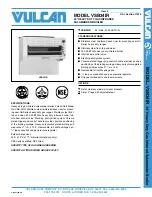
33
11
Boiler Servicing
To ensure efficient operation of the
boiler it is recommended that it is
checked and serviced as necessary
at regular intervals. The frequency
of servicing will depend upon the
particular installation conditions and
usage, but in general once per year
should be adequate.
Servicing and replacement of parts
must only be carried out by a suitably
qualified engineer.
Details of every service should be
entered in the Service Log, in the
Boiler Handbook.
This information may be required
to validate the Grant extended
guarantee.
Before starting any work on the
boiler, or fuel supply please read the
health and safety information given
in Section 14.
11.1 Checking before
Servicing
The following sequential checks should
be made before any servicing:
1. Check the flue terminal and ensure
it is not blocked or damaged.
2. Run the boiler and check the
operation of its controls.
3. Ensure that all water / fuel system
connections and fittings are sound.
Remake any joints and check the
tightness of any fittings that may be
leaking.
4. The boiler is part of a sealed central
heating system; check the system
pressure, check the operation of
the pressure relief valve and check
the expansion vessel air charge.
See Section 7.
5. Refill, vent and re-pressurise
the system as necessary.
See Section 4.
6. Check that the ventilation
openings in the casing are clear.
See Section 9.
7. Remove any sludge / water from
the fuel tank by opening the sludge
valve at the lower end of the tank.
8. With the fuel supply valve closed,
clean / replace the filter element
and clean the filter bowl.
Braided flexible fuel supply hoses as
supplied with the boiler should be
replaced annually when the boiler is
serviced. If long-life hoses have been
installed, these should be inspected
annually. If in doubt replace the hoses.
In any event, these hoses must be
replaced every five years.
Before servicing, set the boiler
On / Off switch to Off, isolate the
electricity supply and close the fuel
supply valve.
Allow the boiler to cool.
The data label on the inside of the case
side panel will indicate the fuel used
and the nozzle fitted.
11.2 dismantling Prior to
Servicing
The procedure for dismantling the boiler
is as follows:
1. Remove the front panel.
2. Carefully lift up and remove the
expansion vessel from the boiler.
3. Remove the burner fixing nut (top
of mounting flange) and withdraw
the burner.
If two flexible pipes are connected
to the burner, identify (mark if
necessary) which is the suction and
return if they are to be disconnected.
11.3 Cleaning the Boiler
The procedure for cleaning the boiler is
as follows:
1. Remove the nuts and washers
securing the front cleaning door and
withdraw the door. Take care -
it is heavy.
2. Remove the baffles as shown in
Figure 11-1, Figure 11-2 or Figure
11-3, as appropriate.
3. Remove all deposits from the baffle
plates and all the boiler internal
surfaces using a stiff brush and
scraper if necessary.
4. Check the condition of the flue,
clean as necessary.
5. Check the condition of the front
cleaning door seal and replace if
necessary.
6. Replace the baffles, ensuring they
are correctly fitted. See Figure
11-1, Figure 11-2 or Figure 11-3,
as appropriate. Pull out the spiral
turbulators from the heat exchanger
tubes. See Figure 11-4.
7. Clean the turbulators using a stiff
brush.
8. Test the heat exchanger
condensate drain by pouring
water into one of the lower tubes
and observe whether the water
discharges from the 22mm
condensate outlet. Replace the
turbulators.
9. Replace the front cleaning door,
ensuring the seal is in good
condition and secure it in position
with the nuts and washers
previously removed. Tighten to form
a seal.
10. Remove the condensate trap and
check that it is not blocked and is
operating correctly, i.e. the float is
free to move. Clean the trap and
float as required.
11. Check that the boiler condensate
outlet is unobstructed. Clean if
necessary.
The condensate trap and condensate
outlet must be checked on every
service and cleaned as necessary.
!
CaUtiOn
!
WarninG
!
WarninG
!
nOtE
!
nOtE
















































